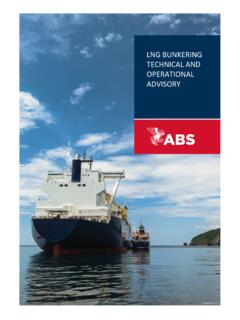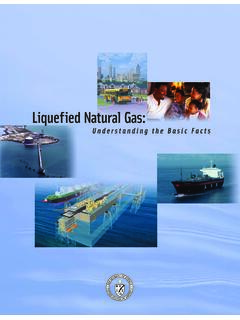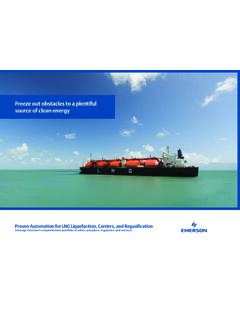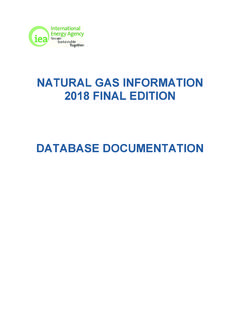Transcription of Liquefied Gas Carriers - Ship Types
1 Abbreviated from: Tanker Safety Training ( Liquefied Gas) Publ Date: Mar 2007 Liquefied Gas Carriers - Ship Types Profile of the world gas fleet The current fleet of Liquefied gas ships in service is approximately 1,100, of which about 800 are LPG Carriers , with over 200 LNG Carriers and approximately 90 ethylene Carriers making up the remainder. Gas Carriers are divided into two main groups. Liquefied Petroleum Gas (LPG) Carriers , which are designed to carry mainly butane, propane, butadiene, propylene, vinyl chloride monomer (VCM) and are able to carry anhydrous ammonia.
2 Liquefied Natural Gas (LNG) Carriers , which are designed to carry Liquefied natural gas (which is mostly methane). Gas Carriers are classed in three Types based on hazard potential: type 1G, designed to carry the most hazardous cargoes type 2G and 2PG, designed to carry cargoes having a lesser degree of hazard type 3G, designed to carry cargoes of the least hazardous nature. Most Gases, including LNG, fall into the category carried on Type 2G or 2PG Gas Carriers . Gas carrier Types All gas cargoes are transported in liquid form (ie they are not carried as a gas in its vapour form) and, because of their physical and chemical properties, they are carried either at: - pressures greater than atmospheric, or at - temperatures below ambient, or a combination of both.
3 Therefore, gas Carriers are generally grouped as follows: Fully Pressurised semi-pressurised and refrigerated fully refrigerated Note. These grouping names are more prevalently used when discussing the classes and Types of LPG Carriers rather than LNG Carriers . Recap on Tank Types used Type A : Constructed of plain surfaces (prismatic tanks) Type B : Spheres Type C : Cylindrical pressure vessels (Note. These tanks are used where appropriate, regardless of gas carrier type) Fully Pressurised Ships Figure __ Fully Pressurised Gas carrier Lady Hilde These were the first generation of ships to carry Liquefied gases.
4 The ships have a cargo capacity up to ~ 3,500 m3. These ships carry the cargo in spherical or cylindrical steel tanks, designed for a working pressure of kg/cm2. This corresponds to the vapour pressure of propane at 45oC, which is the maximum ambient temperature in which the ship is likely to operate. No means of temperature or pressure control is necessary. The tanks are generally Type C spheres and no secondary barrier is required. A double bottom is constructed for ballast water. The hold space around the cargo tanks does not need to be inerted. Advantages They are built with ordinary grades of steel as the cargo is carried at ambient temperature and no insulation is required no reliquefaction plant is required operations are simpler.
5 Disadvantages Due to their shape, the use of underdeck space cannot be optimised high design pressure requires considerable tank wall thickness, with consequent increase in displacement weight and cost the weight in tons of cargo carried is lower than for a refrigerated ship of similar size, due to cargo density difference as the diameter of the tanks increases, the wall thickness increases to withstand the same pressure. The decreasing ratio of cargo carried to weight of tank makes this solution uneconomical over long haul routes. Figure __ Fully pressurised LPG carrier Lady Hilde view forward Figure __ Lady Hilde cross section Figure __ Lady Hilde - side elevation Semi-pressurised / Semi-refrigerated or Semi-pressurised / Fully-refrigerated Figure __ Semi-Pressurised Gas Carrier Kemira Gas General description These vessels are fitted with a refrigeration plant that provides a fully refrigerated ability while having a high design pressure for the cargo tanks (Pressure vessels), albeit below that required for fully pressurised carriage.
6 The tanks are cylindrical in shape and of a thinner construction than the pressurised vessels. Cargo capacity Semi-pressurised, semi-refrigerated ships (which are now quite rare) ranged up to 5,000 m3 in size. Their construction is based on carrying propane at a pressure of kg/cm2, and a temperature of -10 C. Semi-pressurised, fully-refrigerated ships generally range up to 15,000 m3. They can be designed to carry the full range of cargoes in cylindrical or spherical tanks and are designed for a minimum service temperature of -48 C and a working pressure of approx 5 to 8 kg/cm.
7 Temperature control The reliquefaction plant on these vessels generally has a substantial capacity and can, if required, load the cargo as a gas and then reliquefy it onboard. They are able to heat or cool the cargo during loading operations, or while at sea, and are also able to raise the temperature of the cargo when discharging. Where a reliquefaction plant is fitted it will allow a reduction in the wall thickness of the tanks. Note. The thicker the iInsulation surrounding the tank the less work the reliquefaction plant is required to do. Construction The inner hull volume is used more efficiently than the fully pressurised vessels and the number of tanks varies from 2-6.
8 A double bottom is constructed for ballast water and the hold space around the cargo tanks does not need to be inerted. Advantages Their advantages over fully-pressurised ships are: More cargo can be carried in a tank of the same capacity a tank of the same capacity is lighter and cheaper to build much larger and more economical ships can be constructed. Figure __ Semi Pressurised LPG Carrier Kemira Gas view forward Figure __ Kemira Gas cross section Figure __ Kemira Gas Side elevation Fully refrigerated Figure __ Fully Refrigerated Gas Carrier Flanders Harmony General Description The economic advantages of transporting LPG and ammonia in a fully refrigerated, non-pressurised condition are more evident for longer haul and larger quantity cargoes.
9 The self-supporting prismatic shape of the cargo tanks allows for a better utilisation of the available hold space than the type of ships described previously. The tanks are usually designed for a maximum working pressure of about kg/cm2 (280 milibars) and a minimum working temperature of -50oC making them suitable for the carriage of butane, butadiene, VCM, ammonia, propane and propylene. Cargo capacity The ships are typically in the range 15,000 m3 85,000 m3, with three common sizes for LPG/Ammonia trades of 30,000 m3, 52,000 m3 and 80,000m3. LPG Carriers of 80,000m3 Are known as Very Large Gas Carriers VLGC s Temperature control The trend for longer voyages has imposed a demand larger ships, and with the increasing size of the ship, the pumping and refrigeration plant capacity has increased proportionally.
10 Construction The tanks nearly extend to the full width of the ship, with ballast in the double bottom and upper hopper or wing tanks. These tanks normally have a centreline bulkhead fitted with two equalizing valves. You should be cautious should these vessels develop a list alongside as the tanks carry a large free surface area and if the vessel has problems with the ballast or levelling the cargo during load they can quickly list over to 2 or 3 . When carrying LPG the hold space is inerted. Figure __ Fully refrigerated LPG Carrier Eeklo view forward Figure __ Eeklo cross section Figure __ Eeklo side elevation Ethylene Carrier General Description Ethylene Carriers are a special type of gas carrier that can transport ethylene fully-refrigerated at its atmospheric pressure boiling point of -104 C.









